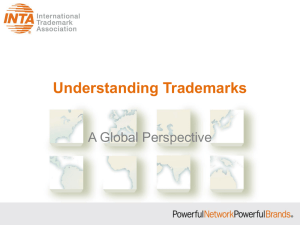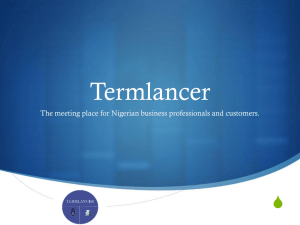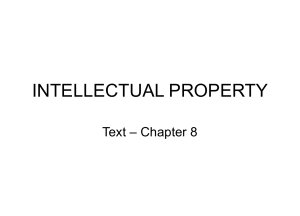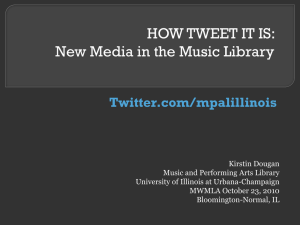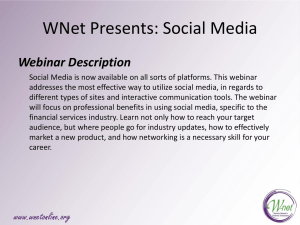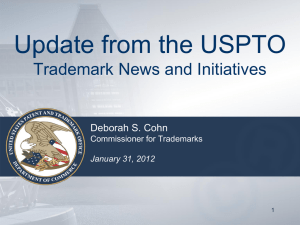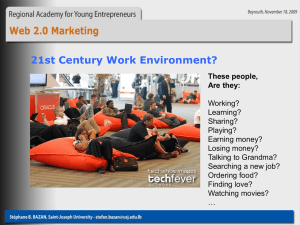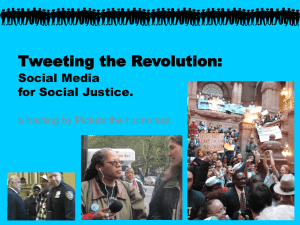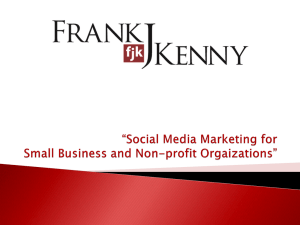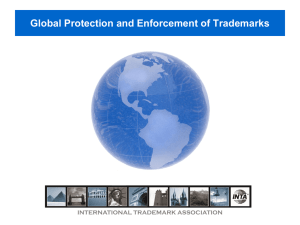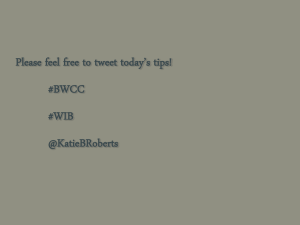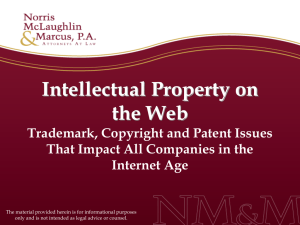Trademark Enforcement in Social Media
advertisement
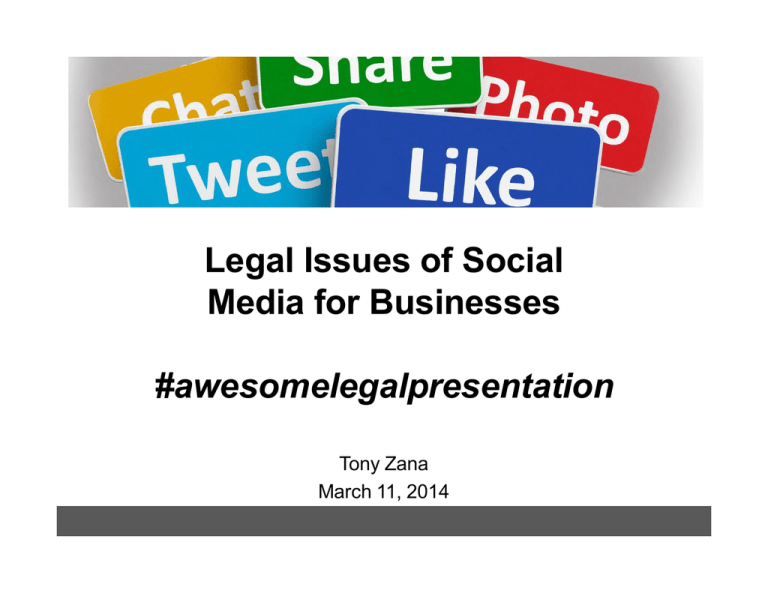
Legal Issues of Social Media for Businesses #awesomelegalpresentation Tony Zana March 11, 2014 Legal Disclaimers These materials have been prepared solely for educational purposes. These materials reflect only the personal views of the author. The presentation does not establish any form of attorney-client relationship. While every attempt was made to ensure that these materials are accurate, errors or omissions may be contained therein, for which any liability is disclaimed. Outline • Legal Challenges for establishing TMs in Social Media • Using Social Media: Pitfalls and Practice Tips • Enforcement of your IP Rights in Social Media Establishing a Trademark Initial Trademark Clearance • Old School: search USPTO for pending or registered trademarks • Today, the USPTO is only half of the story— Internet and social media are helping businesses establish broad trademark rights quickly, long before registration is achievable • Competent trademark searches must consider the broader marketplace—social media, blogs, usernames, WHOIS 5 Trademarks Created Nearly Overnight • The time it takes to create a recognizable and protectable Trademark can also be far less • Example: Grumpy Cat In September 2012, a photo of a grumpy cat was posted on Reddit (user generated news links) and soon after “Grumpy Cat” became an internet sensation and trademark. Today the brand sells t-shirts and other merchandise. 6 Social Media and Mark Clearance • Consider the following sites when seeking clearance: – KnowEM.com searches the “availability” of a trademark on social media sites – AdGooroo.com provides traffic reports on who is bidding on keywords that may tie into your trademark 7 Example: Social Media and Brand Clearance • Although the creator of internet games Farmville and Cityville did not own federal trademark rights to the games, in 2012 it brought suit against a French games company alleging trademark infringement for the Facebook game ‘Pyramidville.’With a social media search, Pyramidville likely would have identified Zynga’s common law rights created through actual use. 8 Brand Protection That Was Too Late 9 Trademarks, Domain Names, and being Proactive • Extensively search all online sources before deciding to use a word or logo as a trademark • Register Trade Marks and Service Marks • Register Domain Names • • Reserve vanity URLs—by creating official company pages, user names, conference names and groups Think not only about first level domain names— .com/.net/.biz/.info • Establish social media accounts on all new platforms Using Social Networking: Pitfalls and Best Practices The Starting Point Threshold Question: Is social media really necessary for your marketing? If your business is not consumer driven, it may not be. And in that case, reducing your social media footprint is a way to reduce brand vulnerability – for most businesses, this will not be the conclusion reached. Social media is a must have for most business. 12 Create a Social Media Policy – An official, company-wide social media policy creates guidelines for use – Purpose—to protect the privacy, confidentiality, and interests of your company – www.socialmediagovernance.com—collection of policies from major companies; useful resource 13 Embarrassing Posts by Companies In 2011, Kenneth Cole used the riots in Cairo to promote its latest collection. Twitter users quickly expressed their disgust of the post by starting the hashtag #boycottKennethCole. The company apologized within hours 14 Bad Employee Posts Personal use violating Company Policy In August 2013, Wade Good, a Lacoste sales person in New York, posted a picture of his paycheck on Instagram, along with the following commentary: Employee violated the confidentiality policy and Lacoste wanted pay rates kept secret • PRACTICE TIP: Facebook is the first place that litigators go to when an individual or company is in a lawsuit 16 Basic Elements of the Policy – Needs to cover professional and individual use of social media – Should be part of the employee handbook/written code of conduct to establish repercussions – Identify specifically what is off limits – – – – – Litigation Non published financials Unreleased product information Anything covered by an NDA Patents (1 year) 17 Social Media Employee Training – A social media training program should outline what behavior the company expects from employees on social media, – Educate employees using examples of good and bad posts – Detail tagging guidelines – Address issues of attribution – Guidance on User name selection 18 Other Recommendations • Install a governance committee • Implement a formal system for management of user names (central process and repository) • Draft a social media brand style guide—purpose is to define the brand personna and ensure the right voice and approach • Consider hashtags and keywords • www.hashtagify.me (identifies popular hashtags) 19 Be Aware of the New FTC Guidelines As of March 2013: The FTC updated its rules and guidelines to specifically address questions of legal compliance that arise when businesses are developing or sponsoring online promotions and advertising. • Endorsements • Fakes • Disclosures 20 Endorsements – An endorser cannot talk about his or her experience with a product if they haven’t actually tried it – An endorser must represent his or her true experience—if he/she thought the product was terrible, he/she cannot say the product was terrific. – If an endorser lost 30lbs in 6 weeks on a diet-pill, but the average is about 10lbs, he or she cannot claim everyone will have the same experience – Paid endorsements must come with a disclaimer (“Ad:” “#ad”) 21 Flogs Flog: A fake blog, or electronic communication appearing to originate from a non-biased source (advertisements, mass emails), but is directly or indirectly created by a company to market a product, service or political viewpoint. Note: Fake reviews violate deceptive business practices and false advertising state laws. In September 2013, the New York Attorney General revealed a year-long undercover investigation that resulted in 19 companies paying over $350,000 in fines for writing fake online reviews. 22 Wal-Mart Flog In September 2006, the blog Wal-Marting Across America was born. The blog followed a couple, Jim and Laura, on their RV journey from Las Vegas to Georgia while parking for free at Wal-Mart stores. The blog highlighted employees who told stories of how much they loved to work at Wal-mart. It was later revealed the flog was written by three PR firm employees working for Wal-Mart and Jim and Laura were paid by Wal-Mart 23 Samsung Fake Comments • In October 2013, Taiwan’s Federal Trade Commission determined that Samsung Electronics paid numerous employees and writers to post negative comments about HTC. • The company was ordered to pay a $340,000 fine 24 Fake Followers • Fake Followers can be purchased online (example fiverr.com) • May constitute a deceptive trade practice under state law and violation of FTC regulations • Violates Facebook’s Terms of Use • At a minimum, looks tacky (followers often “expire”) • Also avoid purchasing fake You Tube product endorsements New FTC Guidelines: Distractions • Proximity and Prominance – The extent to which items in other parts of the advertisement might distract attention from the disclosure Note: Icons, abbreviations and symbols are likely to be overwhelmed by other distractions in an advertisement. In this example, the letters FS are insufficient to show Julie Brown received a free sample. The amount of text significantly distracts the reader from the FS, and there is no guide to explain what FS means. 26 Disclosures • Don’t Rely on Hyperlinks for Disclosure: −Hyperlinks should not be used to communicate disclosures that are an integral part of a claim, including important health and safety information 27 User Generated Content • User-generated content includes everything from blog posts, to website comments to videos, and more • Great for user engagement but you can pick up liability if the users violate the rights of a third party • Two laws you need to know about: Digital Millennium Copyright Act (Title II Online Infringement Liability Act) – safeharbor for copyright liability Communications Decency Act – immunity for those who publish communications of others 28 Copyright: User Generated Content • Example: Someone posts a copyrighted work on your blog or social media page • The “Safe Harbor” Provisions of the Digital Millennium Copyright Act (DMCA) can protect your company from user-generated content liability. Originally designed to protect internet service providers, same protection applies to blog owners. • Provide users notice of: 1. no actual knowledge of infringement 2. written policies regarding copyright infringement, 3. reasonable takedown procedures 4. registered agent with copyright.gov Defamation: User Generated Content Example: In 2009, Sarah Jones, an ex- Bengals cheerleader and former high school teacher brought an invasion of privacy and defamation suit against TheDirty.com for third party’s comments alleging she had STDs. Court found website liable as the provider of the content - - Section 230: No provider or user of an interactive computer service shall be treated as the publisher or speaker of any information provided by another information content provider. Contrasting example: Doe v. My Space – no liability for My Space for stalking and resulting sexual assaults by users 30 Trademark: User-Generated Content • Trademark related claims are not protected under the DMCA or Section 230 of the Communications Decency Act. 31 Contests, Sweepstakes and Lotteries • Contest – prize given on the basis of skill or merit • Sweepstakes/Giveaways – prize given to a person that is randomly selected • Lotteries – prize, chance and consideration DISTINGUISHING ELEMENT IS CONSIDERATION Contests, Sweepstakes and Lotteries • Contests – only requires disclosure of name of sponsor, number of rounds/levels, criteria for winning • Sweepstakes/Giveaways – must have official rules that do not change during event • “no purchase necessary” and “void where prohibited” • Keep value under $5,000 to avoid registration requirements • Lotteries – basically illegal so avoid them Closer call – whether the requirement to “like” your Facebook page is consideration enough to become a sweepstake or lottery Google AdWords • Issue: Can you buy AdWords that are a competitor’s registered Trademark? • Google will not prevent use of a TM either as a keyword or in the text of an ad • Google will investigate use of a TM in the ad text but not as a keyword • However, a direct action may exist from the TM owner but not usually practical Enforcement of IP Rights in the Social Media “Community” Trademark Enforcement in Social Media Traditional Trademark Infringement: Any person who, on or in connection with any goods or services … uses in commerce any word, term, name, symbol, or device…which is likely to cause confusion…with another person, or his or her goods, services, or commercial activities Traditional Cybersquatting: Anyone who, “with [a] bad faith intent to profit from the goodwill of [another's] trademark, registers, traffics in, or uses a domain name” that is identical to, or confusingly similar to, or dilutive to their mark, without regard to the goods or services of the parties. 36 Parody not used in Commerce 37 New Forms of “Infringement” But traditional concepts of infringement may not offer meaningful relief for the various new types of harms that can occur in social media: - Brand-jacking - Impersonation - Bashtags 38 Trademark Enforcement in the Social Media Realm Brand-jacking: The act of assuming the online identity of a business with the intent to acquire the business’ brand equity. This is something that can usually be stopped 39 Brand-Jacking Illustrated In 2010 after the BP oil spill, a twitter user created the parody account @BPGlobalPR to promote other things The account has nearly double the twitter followers as the “official” BP twitter page. The tweets diminish the goodwill of the company’s trademark. 40 Impersonation The act of impersonating another on Facebook or Twitter. Squatting not okay under Twitter rules, but active parody use is okay E-Impersonation laws are proliferating that are broader than TM laws: • Criminal Impersonation: Assume a false identity to fraudulently gain an economic benefit, or pretend to represent an organization or an individual in order to fraudulently gain an economic benefit, criminal impersonation in Alabama. Class B misdemeanor. (Code of Alabama section 13A-9-18) • Phishing: using email, a website or Internet solicitation to access a person’s identifying information. Class C felony (Code of Alabama section 13A-8-114) 41 Twitter Impersonation Illustrated • • • • In 2009 Anthony La Russa, manager of the St. Louis Cardinals, filed suit against Twitter after an unknown user created the account twitter.com/TonyLaRussa using La Russa’s photo, and pretending to post updates as the manager. La Russa claimed trademark infringement and dilution, cybersquatting, and misappropriation of name and likeness. He later dropped the suit – but this led Twitter to start the “Verified Account” program Pranksters had no money to satisfy a judgment and claim against Twitter was unlikely to succeed 42 Bashtags Bashtag: A hashtag that is “hijacked” for criticism or “social media humiliation” No property right in a hashtag; usually results in hashtag being blocked 43 Bashtags Illustrated • In 2012, McDonalds paid to launch a Twitter campaign using the hashtag #McDStories. • Twitter users turned the hashtag into a bashtag sharing McDonald’s horror stories • The company pulled the campaign down within two hours 44 Traditional Enforcement does not Work in Social Media • Generally “Black Letter Law” is not the best source to resolve a social media dispute – From an enforcement perspective, it is still the wild west • Best place to start resolving a social media trademark-like claim is likely with the services operator • Each website’s specific “terms of use” polices and dispute resolution procedures are the best place to start to look for relief 45 Social Media Terms of Use Policies • Facebook Terms of Use: – If a user selects a username or similar identifier for his or her account or page, Facebook provides the right to remove or reclaim the page if Facebook “believes it is appropriate...” • Twitter Terms of Use – Twitter “may” suspend an account or give an account holder “opportunity to clear up any potential confusion” – BUT compare: “Using another's trademark in a way that has nothing to do with the product or service for which the trademark was granted is not a violation of Twitter's trademark policy.” 46 Social Media Terms of Use Policies cont. • Facebook and Twitter—both acknowledge some steps to protect trademarks, but their policies do not: – outline their trademark investigation strategies – set parameters of what would constitute as “abuse” of a mark • Nevertheless, without a registered TM, the namespace operators will likely not take action 47 The Best Defense is a Good Offense • Develop a social-media oriented trademark infringement detection strategy – A detection strategy can help protect against uncharacteristic activity purporting to originate from your company or its management. –www.topsy.com –www.tweetdeck.com – As trademark owners you have an obligation to monitor and enforce your rights. 48 The Best Defense Is a Good Offense cont. • Identify the types of abuse that are most important to your business • Determine the most clear-cut forms of abuse and prioritize detection • Question how fake Twitter pages or LinkedIn accounts affect your brand • Develop relationships with the social media sites that are key to your brand to help enforce and protect against infringement 49 Reacting to Online Problems • Formulate a Crisis-Management Decision Tree – Coordinate between departments within your organization • • • • PR Legal Product Development Executives – Assess benefit of letting it go • Rant? Joke? Factually erroneous? Satire? Rule No. 1: ACT QUICKLY 100 Notre Dame Decision Tree http://onmessage.nd.edu/communications-policies-and-guidelines/social-media-decision-tree/ 51 Policing Your Brand • Just as traditional trademark law is not a panacea, traditional enforcement approaches may backfire – Cease and Desist letters—recognize that it will be posted on the Internet, so tone and content are critical – Trademark Bullying is a widespread complaint these days—generally directed at companies that are perceived to overreach in their enforcement efforts – Be aware that the backlash against patent troll litigation has been extended to IP rights enforcement in general 52 Policing Gone Wrong: Nutella 53 Policing Gone Wrong: Nutella cont. • A Nutella lover created “World Nutella Day” to encourage fans like herself to post pictures, videos and blogs expressing their obsession with Nutella. • Major news outlets helped grow the event from a blogger's invention into an unofficial holiday on February 5th. The World Nutella Day Facebook page had over 40,000 likes. • In April 2013, the company sent the blogger a cease-anddesist letter demanding that she stop publishing anything with the Nutella name, logo or likeness. 54 Policing Gone Wrong: Nutella cont. • In response, fans of the page expressed outrage. “Never bothering with Nutella…Maybe one of these days companies will stop threatening their most passionate customers.,” one user wrote. • Less than a week later, the company dropped the ceaseand-desist request. • With a detection and friendly enforcement strategy in place, the company likely could have avoided public embarrassment. 55 Policing Gone Wrong: Louis Vuitton 56 Policing Your Brand: Louis Vuitton cont. • In 2012, Louis Vuitton sent a cease-and-desist letter to the University of Pennsylvania for the use of the company’s monogram on a flyer promoting a fashion and intellectual property law symposium hosted by a student group. • The letter claimed had the traditional C&D demands and also insulted the Penn Intellectual Property Group‘s understanding of the law • The letter and the University’s response to the company’s counsel went viral. 57 Policing Your Brand Creatively: Jack Daniel’s Dissimilarly, Jack Daniel’s recently used a more creative approach (via e-mail) after discovering the cover of an author’s book closely resembled elements of JACK DANIEL’s trademarks, and was allegedly infringing. 58 Policing Your Brand Creatively 59 Conclusions 1. Stake your claim 2. Ask first 3. Stay current on rules 4. Use safeharbors 5. Have contest rules 6. Monitor your marks 7. Choose your battles 8. Enforce smartly 9. Set parameters with employees 10.Use your lawyer
